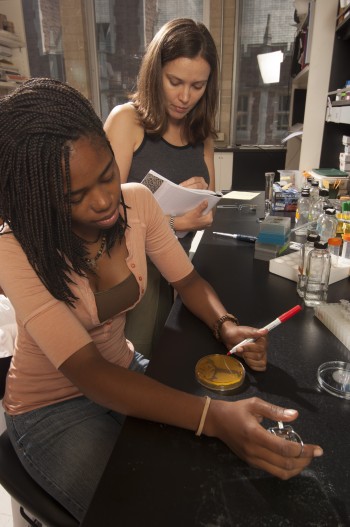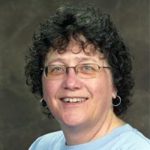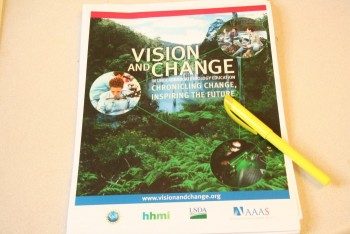The “Vision and Change” Report
 Biological literacy is crucial for understanding and addressing many of the challenges that our global society faces today. Moreover, rapid advances in the life sciences, cognitive neuroscience, and the learning sciences support the need for evolving our pedagogical approaches to teaching science.
Biological literacy is crucial for understanding and addressing many of the challenges that our global society faces today. Moreover, rapid advances in the life sciences, cognitive neuroscience, and the learning sciences support the need for evolving our pedagogical approaches to teaching science.
Recognizing the need for change in how the life sciences are taught, in 2007, the American Association for the Advancement of Science (AAAS), with support from the National Science Foundation (NSF), Howard Hughes Medical Institute (HHMI), and National Institutes of Health (NIH), began a series of regional conversations focused on improving education in the life sciences. These conversations—among leading life-science faculty and researchers, administrators, pedagogy experts, professional life-sciences organization representatives, and graduate and undergraduate students—led to a 2009 NSF-AAAS-sponsored conference on how to improve life-science education.
Recommendations focused on areas including
- Evidence-based pedagogical innovations (such as including authentic research experiences in courses and programs)
- Assessment of student learning and program effectiveness
- Core concepts and competencies for 21st century life-science students
- Professional development for faculty (in areas such as active-learning pedagogies as well as reflective teaching)
- Institutional culture change to support these innovations
- Infrastructure, resources, and tools to enable these changes at the course-level, department-level, and institutional level
These recommendations are considered at length in the American Association for the Advancement of Science (AAAS) 2011 report, “Vision and Change in Undergraduate Life Science Education: A Call to Action.” Except for the core concepts of life sciences, all the recommendations in this report are applicable across the sciences, and many apply to all disciplines.
The Partnership for Undergraduate Life Science Education (PULSE)
A collaboration of NSF, NIH, and HHMI, the Partnership for Undergraduate Life Science Education (PULSE) formed to catalyze the integration of recommendations outlined in the Vision and Change report into life science programs nationwide. The PULSE Steering Committee selected a cohort of life-sciences deans and department chairs to serve as PULSE “Vision and Change” Leadership Fellows. These fellows were charged with developing a framework to accelerate the adoption of recommendations from the “Vision and Change” report. In the first fellowship year, one working group of Fellows developed rubrics designed for life science departments to use in reflecting, assessing, and discussing their approaches to teaching and learning in their programs. The rubrics were designed for use by diverse institutions, including large state schools, smaller private schools, and community colleges.
 Washington University Professor and Chair of Biology Kathy Miller is part of the first cohort of PULSE Fellows that developed the rubrics and piloted their use in a program to recognize and reward departments that had progressed in implementation of these recommendations.
Washington University Professor and Chair of Biology Kathy Miller is part of the first cohort of PULSE Fellows that developed the rubrics and piloted their use in a program to recognize and reward departments that had progressed in implementation of these recommendations.
View Pilot Results
Miller offers her thoughts on the needs driving the PULSE project:
It is well known that most students interested in STEM drop out of those fields early in college – and one reason is they lose interest. Science is largely being taught as ‘factual information.’ But that is not what scientists do, and that is not why most students are interested in science – kids are naturally curious and want to ‘investigate.’ But the way we teach science drives them away. Look, if you want to teach someone to play baseball or dance, do you have them read and memorize the instructions? No, of course not! You teach them by letting them do it, practice it, and experience the excitement associated with it. It’s important that we understand what is happening in our STEM classrooms and improve what we teach and how we teach it so that we keep people interested in science. We need scientists and we need educated citizens who understand science if we are to solve the many problems that face our world.
CIRCLE’s Role in the PULSE Project
In collaboration with the PULSE Steering Committee, CIRCLE researchers are lending their expertise to PULSE’s mission. The project is a longitudinal study, spanning approximately five years. The aim is to assess the progress of life-sciences departments nationwide in implementing and sustaining the recommendations from the “Vision and Change” report.
 Overall, this project seeks to collect data to determine nationwide the status of educational practice in life sciences programs and other STEM departments and to track whether that practice is changing over time. The first data collection by the PULSE group was during 2013-2014, and CIRCLE began working on the project in January 2015. CIRCLE currently has baseline data from approximately 70 schools.
Overall, this project seeks to collect data to determine nationwide the status of educational practice in life sciences programs and other STEM departments and to track whether that practice is changing over time. The first data collection by the PULSE group was during 2013-2014, and CIRCLE began working on the project in January 2015. CIRCLE currently has baseline data from approximately 70 schools.
The main part of CIRCLE’s work is doing analysis to help validate the survey instrument PULSE is using to initially assess the life-science departments and track their progress in implementing changes over time. Additionally, the CIRCLE team hopes to use the instrument to determine what factors are associated with successful implementation of changes.
Mike Cahill, CIRCLE research scientist and project manager, notes “This project is unique in trying to collect data of this type systematically. By providing a way to measure this progress, we can help science departments improve.”
The Departmental Self-Perception Survey
The instrument to measure adoption of “Vision and Change” recommendations is a survey of departments’ self-perceptions, asking questions within a number of target-areas, such as
- Curriculum alignment: Are core concepts and competencies outlined in the “Vision and Change” report being taught? Is science as a process foregrounded–rather than science as a collection of facts? Are connections between science and society part of the curriculum?
- Assessment: Is the department assessing how effective teaching is through student-learning outcomes? Is student retention being assessed? Is information on student preparedness and interests being used to shape the curriculum?
- Student practice/support: How much do faculty require students to do inquiry-based learning? How much are students taught metacognition and reflection on their learning processes? How much are faculty providing supplemental learning opportunities (such as tutoring and peer mentoring) outside of class?
- Faculty development: How aware are faculty about discipline-based education research (DBER)? How much do faculty share pedagogical approaches and teaching practices with their colleagues? How much faculty orientation and mentoring is happening in the department?
- Infrastructure: Does the institution have flexible, re-configurable learning spaces for active learning in groups of all sizes? Do rooms allow mixed use—allowing movement between lecture and lab? Do classrooms and labs accommodate special needs?
- Climate for change: Is the administration aware of the national transformation of science education? Does the administration support the development of teaching-related resources for faculty to refine their teaching and faculty incentives for teaching innovation?
CIRCLE researchers have finished collecting the baseline data and validating the initial instrument and are looking forward to examining changes in the departments across time.
In closing, Professor Miller sums up the potential impact of the PULSE project:
Implementing evidence-based pedagogy or active-learning and student-centered activities in classrooms is known to improve learning and engagement. By stimulating these improvements, we will keep more students in science. And we will better educate those who don’t choose to major in science, but who need to develop the scientific literacy to be informed global citizens.
Publications
Brancaccio-Taras, L., Pape-Lindstrom, P., Peteroy-Kelly, M., Aguirre, K., Awong-Taylor, J., Balser, T., … & Marley, K. (2016). The PULSE Vision & Change Rubrics, Version 1.0: A Valid and Equitable Tool to Measure Transformation of Life Sciences Departments at All Institution Types. CBE-Life Sciences Education, 15(4), ar60. http://www.lifescied.org/content/15/4/ar60.short